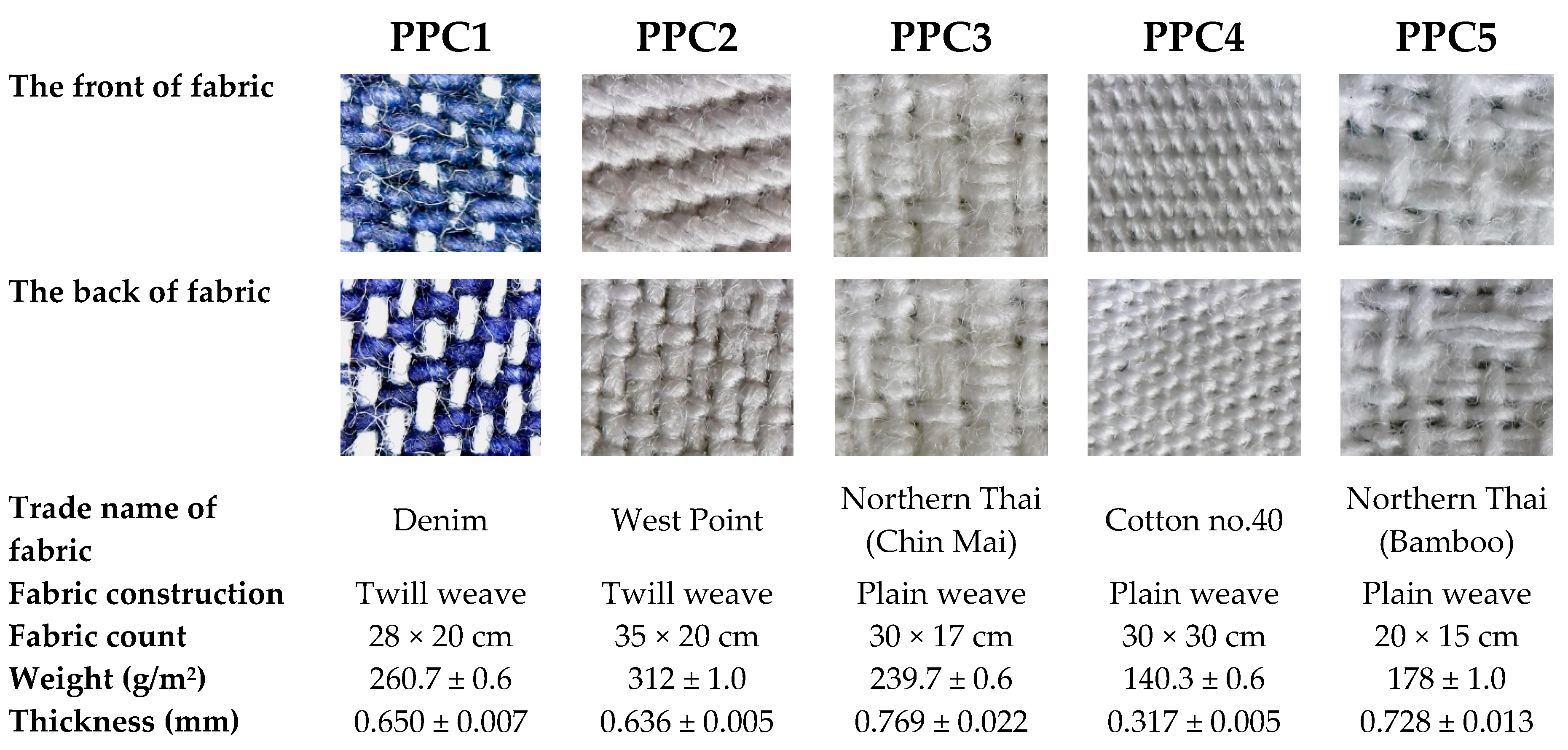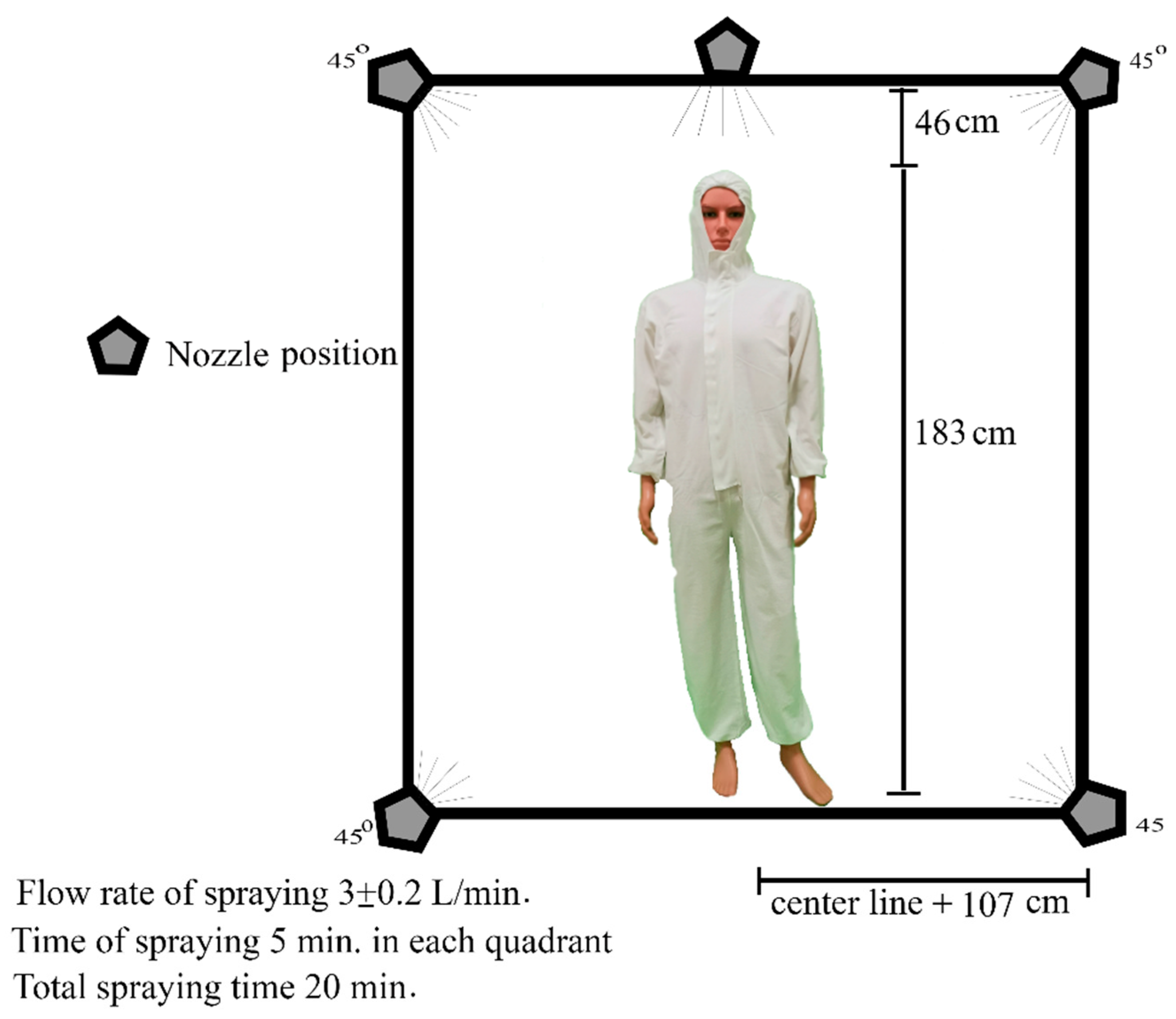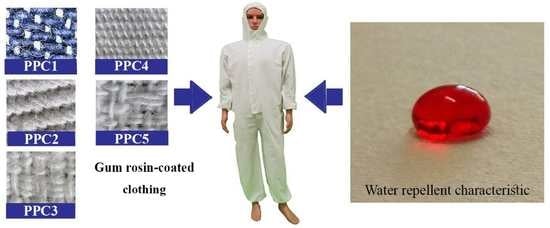Development of Personal Protective Clothing for Reducing Exposure to Insecticides in Pesticide Applicators
Abstract
1. Introduction
2. Materials and Methods
2.1. Coating of Personal Protective Clothing with Gum Rosin
2.2. Test Insecticides
2.3. Closed Chamber Testing of the Protective Efficiency of the Gum Rosin-Coated PPC
2.4. Measurement of Protection Efficiency of the Gum Rosin-Coated PPC
2.5. Analysis of Insecticides
2.6. Quality Control
2.7. Data Analysis
3. Results
3.1. Actual Dermal Exposure (ADE) and Potential Dermal Exposure (PDE) for the Total Surface Body of Manikin
3.2. Protection Efficiency of the Gum Rosin-Coated PPC
4. Discussion
5. Conclusions
6. Patents
Author Contributions
Funding
Acknowledgments
Conflicts of Interest
References
- Damalas, C.A.; Koutroubas, S.D. Farmers’ Exposure to Pesticides: Toxicity Types and Ways of Prevention. Toxics 2016, 4, 1. [Google Scholar] [CrossRef] [PubMed]
- Damalas, C.A.; Eleftherohorinos, I.G. Pesticide Exposure, Safety Issues, and Risk Assessment Indicators. Int. J. Environ. Res. Public Health 2011, 8, 1402–1419. [Google Scholar] [CrossRef] [PubMed]
- Fenske, R.A.; Farahat, F.M.; Galvin, K.; Fenske, E.K.; Olson, J.R. Contributions of inhalation and dermal exposure to chlorpyrifos dose in Egyptian cotton field workers. Int. J. Occup. Environ. Health 2012, 18, 198–209. [Google Scholar] [CrossRef] [PubMed]
- Burns, C.; Mahlburg, W.; Dutra, J.P.J. Pesticide exposure among farm workers. Environ. Res. 2007, 105, 285–288. [Google Scholar] [CrossRef]
- Baldi, I.; Lebailly, P.; Jean, S.; Rougetet, L.; Dulaurent, S.; Marquet, P. Pesticide contamination of workers in vineyards in France. J. Expo. Sci. Environ. Epidemiol. 2006, 16, 115–124. [Google Scholar] [CrossRef]
- Macfarlane, E.; Carey, R.; Keegel, T.; El-Zaemay, S.; Fritschi, L. Dermal exposure associated with occupational end use of pesticides and the role of protective measures. Saf. Health Work 2013, 4, 136–141. [Google Scholar] [CrossRef]
- Yarpuz-Bozdogan, N. The importance of personal protective equipment in pesticide applications in agriculture. Curr. Opin. Environ. Sci. Health 2018, 4, 1–4. [Google Scholar] [CrossRef]
- Thouvenin, I.; Bouneb, F.; Mercier, T. Operator dermal exposure and protection provided by personal protective equipment and working coveralls during mixing/loading, application and sprayer cleaning in vineyards. Int. J. Occup. Saf. Ergon. 2017, 23, 229–239. [Google Scholar] [CrossRef]
- Protano, C.; Guidotti, M.; Vitali, M. Performance of different work clothing types for reducing skin exposure to pesticides during open field treatment. Bull. Environ. Contam. Toxicol. 2009, 83, 115–119. [Google Scholar] [CrossRef]
- Kim, R.; Kwon, Y.; Lee, H.; Limb, J. Safety evaluation of pesticide-proof materials for agricultural clothing using in-vivo test. 6th International Conference on Applied Human Factors and Ergonomics (AHFE 2015) and the Affiliated Conferences, AHFE 2015. Procedia Manuf. 2015, 3, 1888–1895. [Google Scholar] [CrossRef][Green Version]
- Garrigou, A.; Laurent, C.; Berthet, A.; Colosio, C.; Jas, N.; Daubas-Letourneux, V.; Jackson Filho, J.M.; Jouzel, J.N.; Samuel, O.; Baldi, I.; et al. Critical review of the role of PPE in the prevention of risks related to agricultural pesticide use. Saf. Sci. 2020, 123, 104527. [Google Scholar] [CrossRef]
- Jallow, M.F.; Awadh, D.G.; Albaho, M.S.; Devi, V.Y.; Thomas, B.M. Pesticide knowledge and safety practices among farm workers in Kuwait: Results of a survey. Int. J. Environ. Res. Public Health 2017, 14, 340. [Google Scholar] [CrossRef] [PubMed]
- Andrade-Rivas, F.; Rother, H.A. Chemical exposure reduction: Factors impacting on South African herbicide sprayers’ personal protective equipment compliance and high risk work practices. Environ. Res. 2015, 142, 34–45. [Google Scholar] [CrossRef] [PubMed]
- Watson, C.; Troynikov, O.; Lingard, H. Design considerations for low-level risk personal protective clothing: A review. Ind. Health 2019, 7, 306–325. [Google Scholar] [CrossRef] [PubMed]
- Varghese, B.M.; Hansen, A.L.; Williams, S.; Bi, P.; Pisaniello, D.L. Heat-related injuries in Australian workplaces: Perspectives from health and safety representatives. Saf. Sci. 2020, 126, 104651. [Google Scholar] [CrossRef]
- Sapbamrer, R.; Thammachai, A. Factors affecting use of personal protective equipment and pesticide safety practices: A systematic review. Environ. Res. 2020, 185, 109444. [Google Scholar] [CrossRef]
- Sapbamrer, R. Pesticide use, poisoning, and knowledge and unsafe occupational practices in Thailand. New Solut. 2018, 28, 283–302. [Google Scholar] [CrossRef]
- Zhang, X.; Raheel, M. Statistical model for predicting pesticide penetration in woven fabrics used for chemical protective clothing. Bull. Environ. Contam. Toxicol. 2003, 70, 652–659. [Google Scholar] [CrossRef]
- Shaw, A.; Schiffelbein, P. Protective clothing for pesticide operators: Part I—selection of a reference test chemical for penetration testing. Int. J. Occup. Saf. Ergon. 2016, 22, 1–6. [Google Scholar] [CrossRef]
- Shaw, A.; Schiffelbein, P. Protective clothing for pesticide operators: Part II—data analysis of fabric characteristics. Int. J. Occup. Saf. Ergon. 2016, 22, 7–11. [Google Scholar] [CrossRef]
- Lee, S.; Obendorf, S.K. Statistical model of pesticide penetration through woven work clothing fabrics. Arch. Environ. Contam. Toxicol. 2005, 49, 266–273. [Google Scholar] [CrossRef] [PubMed]
- Das, D.; Pandit, P.; Maiti, S.; Dalapati, K.K. Development of protective clothing for pesticide operation. Int. Res. J. Eng. Technol. 2016, 3, 851–855. [Google Scholar]
- Rahman Bhuiyan, M. Polyurethane-aerogel incorporated coating on cotton fabric for chemical protection. Prog. Org. Coat. 2019, 131, 100–110. [Google Scholar] [CrossRef]
- Espanhol-Soares, M.; Nociti, L.A.; Machado-Neto, J.G. Procedures to evaluate the efficiency of protective clothing worn by operators applying pesticide. Ann. Occup. Hyg. 2013, 57, 1041–1053. [Google Scholar] [PubMed]
- Oliveira, M.L.; Machado-Neto, J.G. Permeability of two types of cotton fabric used in personal protective clothing to the insecticide methamidophos. Bull. Environ. Contam. Toxicol. 2005, 75, 1156–1162. [Google Scholar] [CrossRef] [PubMed]
- National Science and Technology Development Agency (NSTDA), Thailand. 2016. Available online: https://www.thailandtechshow.com/view_techno.php?id=34 (accessed on 12 May 2019).
- Deng, B.; Cai, R.; Yu, Y.; Jiang, H.; Wang, C.; Li, J.; Li, L.; Yu, M.; Li, J.; Xie, L.; et al. Laundering durability of superhydrophobic cotton fabric. Adv. Mater. 2010, 22, 5473–5477. [Google Scholar] [CrossRef]
- Palkin, S.; Smith, W.C. A new non-crystallizing gum rosin. Oil Soap. 1938, 15, 120–122. [Google Scholar] [CrossRef]
- National Library of Medicine, National Center for Biotechnology Information. PubChem. Available online: https://pubchem.ncbi.nlm.nih.gov/compound/Gum-rosin (accessed on 5 May 2020).
- The Organisation for Economic Co-operation and Development (OECD). Guidance Document for the Conduct of Studies of Occupational Exposure to Pesticides during Agricultural Application. Available online: https://www.oecd-ilibrary.org/environment/guidance-document-for-the-conduct-of-studies-of-occupational-exposure-to-pesticides-during-agricultural-application_9789264078079-en (accessed on 15 January 2019).
- Sapbamrer, R.; Hongsibsong, S. Organophosphorus pesticide residues in vegetables from farms, markets, and a supermarket around Kwan Phayao Lake of Northern Thailand. Arch. Environ. Contam. Toxicol. 2014, 67, 60–67. [Google Scholar] [CrossRef]
- Pakvilai, N.; Prapamontol, T.; Thavornyutikarn, P.; Hongsibsong, S.; Santasup, C. A simple and sensitive GC-ECD method for detecting synthetic pyrethroid insecticide residues in vegetable and fruit samples. CMU J. Sci. 2015, 42, 197–208. [Google Scholar]
- Li, Z.; Liu, W.; Wu, C.; She, D. Effect of spraying direction on the exposure to handlers with hand-pumped knapsack sprayer in maize field. Ecotoxicol. Environ. Saf. 2019, 170, 107–111. [Google Scholar] [CrossRef]
- Gao, B.; Tao, C.; Ye, J.; Ning, J.; Mei, X.; Jiang, Z.; Chen, S.; She, D. Measurement of operator exposure to chlorpyrifos. Pest. Manag. Sci. 2014, 70, 636–641. [Google Scholar] [CrossRef] [PubMed]
- Vitali, M.; Protano, C.; Del Monte, A.; Ensabella, F.; Guidotti, M. Operative modalities and exposure to pesticides during open field treatments among a group of agricultural subcontractors. Arch. Environ. Contam. Toxicol. 2009, 57, 193–202. [Google Scholar] [CrossRef] [PubMed]
- Coffman, C.W.; Obendorf, S.K.; Derksen, R.C. Pesticide deposition on coveralls during vineyard applications. Arch. Environ. Contam. Toxicol. 1999, 37, 273–279. [Google Scholar] [CrossRef] [PubMed]
- Rincón, V.J.; Páez, F.C.; Sánchez-Hermosilla, J. Potential dermal exposure to operators applying pesticide on greenhouse crops using low-cost equipment. Sci. Total Environ. 2018, 630, 1181–1187. [Google Scholar] [CrossRef]
- Quain, R.D.; Militello, G.; Crawford, G.H. Allergic contact dermatitis caused by colophony in an epilating product. Dermatitis 2007, 18, 96–98. [Google Scholar] [CrossRef] [PubMed]
- Espanhol-Soares, M.; Teodoro de Oliveira, M.; Machado-Neto, J.G. Loss of effectiveness of protective clothing after its use in pesticide sprays and its multiple washes. J. Occup. Environ. Hyg. 2017, 14, 113–123. [Google Scholar] [CrossRef] [PubMed]


| Pesticide | LOD (µg) | LOQ (µg) | Correlation (r2) | Recovery % | Precision, % RSD | |||
|---|---|---|---|---|---|---|---|---|
| Low | Medium | High | Intra-Bath (n = 10) | Inter-Bath (n = 5) | ||||
| Chlorpyrifos | 0.020 | 0.025 | 0.99890 | 98.1 | 85.5 | 126.5 | 5.7 | 3.0 |
| Cypermethrin | 0.012 | 0.025 | 0.99945 | 93.9 | 102.1 | 98.2 | 6.1 | 7.6 |
| ADE/PDE | Chlorpyrifos(μg) | Cypermethrin(μg) | |||
|---|---|---|---|---|---|
| Mean ± SD. | Median | Mean ± SD. | Median | ||
| ADE | (n = 6) | 41,982.38 ± 6734.00 | 41,828.42 | 52,580.36 ± 7502.34 | 54,711.38 |
| PDE | PPC1 (n = 6) | 14.15 ± 7.67 | 11.71 | 56.01 ± 55.88 | 37.47 |
| PPC2 (n = 6) | 25.41 ± 16.58 | 24.99 | 148.13 ± 111.58 | 134.29 | |
| PPC3 (n = 6) | 29.76 ± 49.35 | 8.91 | 222.68 ± 290.48 | 160.88 | |
| PPC4 (n = 6) | 61.80 ± 98.31 | 27.83 | 468.16 ± 744.30 | 219.45 | |
| PPC5 (n = 6) | 6660.36 ± 6070.98 | 6642.88 | 85,026.91 ± 29,890.51 | 75,157.34 | |
| Tychem® C coveralls (n = 6) | 21.36 ± 8.92 | 21.35 | nd | nd | |
| Types of Clothing | Chlorpyrifos | Cypermethrin | ||||
|---|---|---|---|---|---|---|
| Mean ± SD. | Median | p-Value | Mean ± SD. | Median | p-Value | |
| PPC1 (n = 6 ) a | 99.97 ± 0.02 | 99.97 | <0.001 ae,be,ce,de,ef | 99.89 ± 0.11 | 99.93 | <0.001 ae,be,ce,de,ef |
| PPC2 (n = 6) b | 99.94 ± 0.04 | 99.94 | 99.72 ± 0.21 | 99.74 | ||
| PPC3 (n = 6) c | 99.93 ± 0.12 | 99.98 | 99.58 ± 0.55 | 99.69 | ||
| PPC4 (n = 6) d | 99.85 ± 0.23 | 99.93 | 99.11 ± 1.42 | 99.58 | ||
| PPC5 (n = 6) e | 84.14 ± 14.46 | 84.18 | −61.71 ± 56.85 | −42.94 | ||
| Tychem® C coveralls (n = 6) f | 99.95 ± 0.02 | 99.95 | 100 ± 0 | 100 | ||
© 2020 by the authors. Licensee MDPI, Basel, Switzerland. This article is an open access article distributed under the terms and conditions of the Creative Commons Attribution (CC BY) license (http://creativecommons.org/licenses/by/4.0/).
Share and Cite
Naksata, M.; Watcharapasorn, A.; Hongsibsong, S.; Sapbamrer, R. Development of Personal Protective Clothing for Reducing Exposure to Insecticides in Pesticide Applicators. Int. J. Environ. Res. Public Health 2020, 17, 3303. https://doi.org/10.3390/ijerph17093303
Naksata M, Watcharapasorn A, Hongsibsong S, Sapbamrer R. Development of Personal Protective Clothing for Reducing Exposure to Insecticides in Pesticide Applicators. International Journal of Environmental Research and Public Health. 2020; 17(9):3303. https://doi.org/10.3390/ijerph17093303
Chicago/Turabian StyleNaksata, Manoch, Anucha Watcharapasorn, Surat Hongsibsong, and Ratana Sapbamrer. 2020. "Development of Personal Protective Clothing for Reducing Exposure to Insecticides in Pesticide Applicators" International Journal of Environmental Research and Public Health 17, no. 9: 3303. https://doi.org/10.3390/ijerph17093303
APA StyleNaksata, M., Watcharapasorn, A., Hongsibsong, S., & Sapbamrer, R. (2020). Development of Personal Protective Clothing for Reducing Exposure to Insecticides in Pesticide Applicators. International Journal of Environmental Research and Public Health, 17(9), 3303. https://doi.org/10.3390/ijerph17093303






